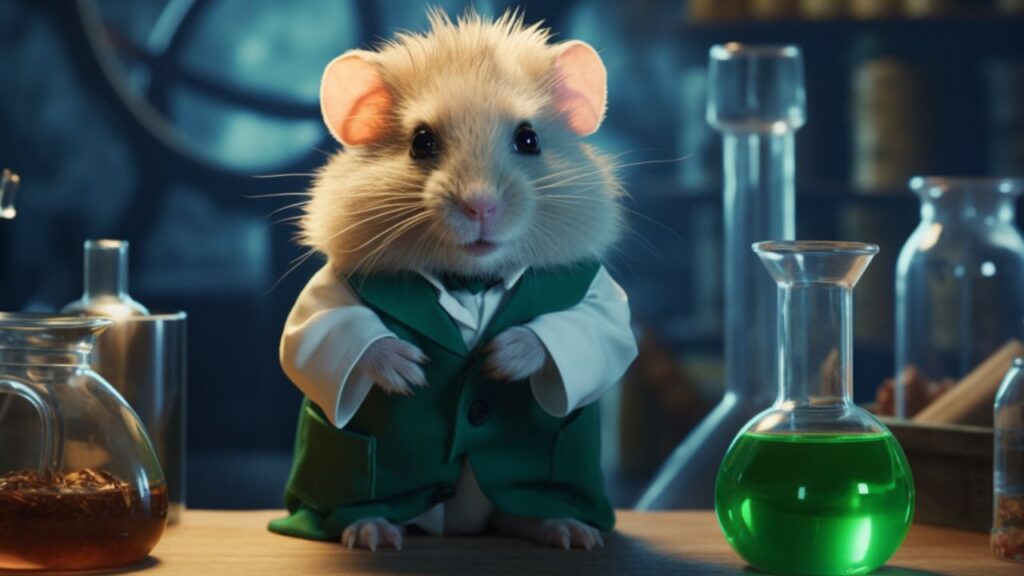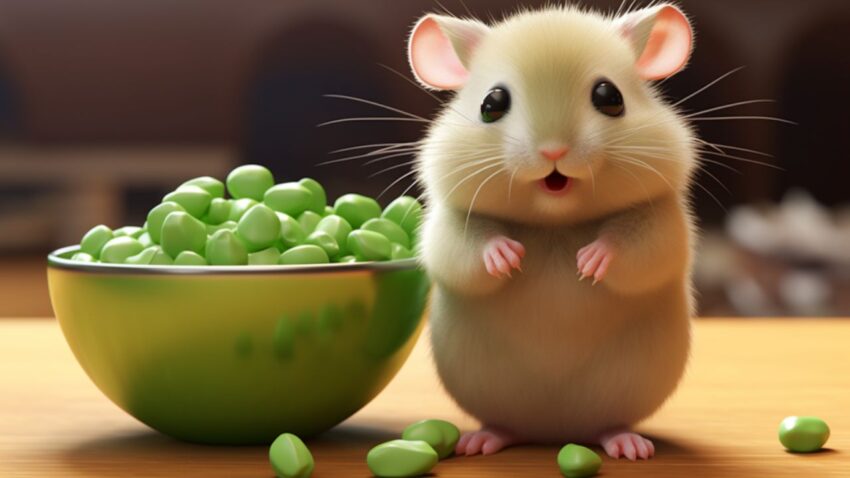TL;DR Summary
Yes, hamsters can eat edamame in moderation, but with some precautions. Edamame beans are soybeans harvested at a young age, packed with protein, fiber, vitamins, and minerals. However, the high protein and fat content can be excessive for a hamster’s daily intake, so it’s vital to serve it as an occasional treat rather than a staple food.
Differing opinions exist in the hamster community about feeding edamame, but the consensus leans towards its safety when offered responsibly. It’s essential to feed unsalted, unseasoned, and thoroughly cooked edamame beans to hamsters and always monitor for any adverse reactions.
For best results:
- Introduce edamame slowly into your hamster’s diet.
- Offer only small pieces and ensure there’s no leftover to prevent mold.
- Avoid feeding the shell to your hamster.
Remember, a happy hamster is a wheel-y happy you!
The intricate world of hamster nutrition is both a marvel and a mystery. These petite pets, often fitting snugly in the palms of our hands, have dietary needs that are as unique as they are diverse. While a hamster’s diet typically consists of seeds, grains, and occasional fruits or veggies, every now and then, an unconventional food item piques the interest of hamster owners. Edamame, a green soybean delicacy enjoyed by many humans, is one such item. As we embark on this exploration, let’s unravel the suitability of this protein-rich snack for our furry companions.
Introducing the curiosity surrounding hamster diets
Hamsters, those tiny balls of fur with insatiable curiosity, are not just fascinating to observe, but also come with a responsibility – ensuring their well-being through a balanced diet. As the world of hamster enthusiasts grows, so does the list of dietary do’s and don’ts. From the array of seeds to the colorful spectrum of fruits and vegetables, each inclusion in their diet is met with a blend of excitement and caution.
Posing the specific question about edamame
Among the myriad of potential treats, the humble edamame stands out. A green soybean, popularly savored by humans across the globe, it’s natural to wonder if this protein-packed snack could be a healthy addition to a hamster’s diet. As we delve deeper into this article, we’ll be exploring this very question, diving into the nutritional aspects of edamame and determining if it’s a treat our tiny friends can enjoy or if it’s best left off the menu.
Edamame: What’s the Bean Deal?

When we think of the foods we enjoy, it’s natural to wonder if our furry companions can share in those delights. One such food item that has gained global popularity is edamame. These vibrant green soybeans, often relished as snacks or accompaniments, are packed with nutrition. But while they may be beneficial for humans, do they hold the same value for our hamster friends? In the intricate world of rodent diets, understanding what foods are permissible and which ones might be harmful is paramount. Let’s delve deeper into the realm of edamame and its place in a hamster’s diet.
A brief introduction to edamame: what it is and its nutritional components
Edamame, often gracing the plates of sushi lovers, is nothing but young soybeans, harvested before they have ripened or hardened. Typically presented in bright green pods, they’re not just visually appealing but are also packed with a powerful nutritional punch. Rich in proteins, fiber, and a host of vital vitamins and minerals such as vitamin K, folate, and manganese, edamame is a beloved snack among health enthusiasts. But, while humans can reap a multitude of benefits from this leguminous treat, does the same apply to our hamster friends?
Importance of understanding dietary restrictions for hamsters
It’s no overstatement to say that a hamster’s well-being largely pivots on its diet. Their tiny bodies have specific needs, and what might be a nutritional powerhouse for us might not sit well in their delicate digestive tracts. Hamsters, though omnivorous, have dietary requirements that lean more towards herbivorous. This means while they can process plant-based foods efficiently, they are sensitive to certain ingredients and compounds. For instance, foods high in sugar or certain proteins can be problematic. Understanding these dietary nuances is crucial, as it not only ensures our pets lead a healthier life but also prevents potential health pitfalls. The onus, therefore, rests on us to discern what makes the cut and what doesn’t in their dietary world, and edamame, with its complex nutritional profile, is no exception.
Scientific Data & Nutritional Analysis

In the vast universe of nutrition, understanding the specifics of what we, and our pets, consume is pivotal. The benefits or potential harms of a particular food often lie hidden within its nutritional makeup. Edamame, a treasured snack for many, boasts a plethora of nutritional components. But the pressing question remains: How does the nutritional profile of edamame stack up against the dietary requirements of hamsters? Drawing from scientific studies and deep-rooted knowledge in rodentology, we’ll dissect edamame’s composition and juxtapose it against the established dietary needs of hamsters.
Breaking Down the Nutritional Components of Edamame
Edamame beans, young soybeans harvested before they’ve ripened, are a rich source of various nutrients. They contain:
- Proteins: An essential component for muscle and tissue repair, edamame is a significant source of plant-based protein.
- Fibers: Beneficial for digestive health, these beans contain both soluble and insoluble fiber.
- Vitamins: Particularly rich in Vitamin K, which aids in blood clotting, and Folate, crucial for DNA synthesis and repair.
- Minerals: Edamame is a treasure trove of minerals like iron, magnesium, and phosphorus.
- Isoflavones: A type of plant estrogen (phytoestrogen) that has various health benefits, including antioxidative properties.
Comparison to Hamster Dietary Needs Based on Scientific Research
Hamsters, like all creatures, have a unique set of dietary requirements. Their diet should be:
- Rich in Protein: Essential for growth and maintenance, especially for young and pregnant hamsters.
- Moderate in Fats: Crucial for energy and the absorption of certain vitamins.
- High in Fiber: Aids in their digestion and promotes gut health.
- Vitamins & Minerals: Necessary for various biochemical processes, including bone health and blood clotting.
Comparing edamame’s nutritional profile to a hamster’s needs, we notice some clear synergies. The protein and fiber content in edamame aligns well with a hamster’s dietary preferences. However, the phytoestrogen content in edamame raises a flag. While isoflavones have shown potential benefits in humans, their impact on hamsters remains less researched and could pose unknown risks.
In the realm of scientific literature, there’s a paucity of direct studies on hamsters consuming edamame. Thus, while the nutritional breakdown suggests some benefits, caution is recommended due to the potential unknowns associated with phytoestrogens.
Dr. Whiskerson’s Observations & Anecdotes

Navigating the vast world of hamster diets, filled with its intricate nuances and delightful discoveries, has been one of the paramount experiences of my professional journey. Among the myriad foods and treats I’ve introduced to these little furry companions, edamame holds a place of particular prominence, not just for its nutritional intrigue but for the range of reactions it elicits.
Personal Observations Regarding Hamsters and Edamame
Delving deeper into the world of hamsters and their dietary inclinations, I’ve consistently found that the introduction of novel foods is akin to opening a box of surprises – you never quite know what to expect. Edamame, in this context, is no different.
- Initial Hesitancy: The world is a vast playground for these petite creatures. However, like every one of us faced with something unfamiliar, hamsters showcase an endearing caution. Their initial approach to edamame often mirrors this sentiment – a delicate sniff, a gentle touch, perhaps a tentative nibble, all indicating an in-built instinct to ensure safety.
- Texture Play: Beyond the initial hesitancy, there’s a palpable intrigue that edamame brings, largely due to its texture. It’s neither hard like their regular pellets nor entirely soft like fruits. This firm yet malleable texture often becomes a canvas for exploration. I’ve observed hamsters roll the beans around, nibble them bit by bit, or sometimes just playfully toss them around before finally settling down for a taste.
- Differing Tastes: The taste palette of hamsters, much like humans, is diverse. While some hamsters would joyfully munch down on edamame, relishing every bite, others seem more indifferent, taking a bite or two and then wandering off in search of other treats.
Memorable Hamster-Edamame Moments
Through my years of close interaction and observation, certain moments etch themselves into memory, painting a vivid picture of the hamster-edamame dynamic.
- Muffin’s Great Heist: Once, during a group feeding session, little Muffin made it her mission to collect as many edamame beans as she could. With cheeks bulging, she ambitiously tried to pick up a fourth bean, resulting in a hilariously cute balancing act that had everyone in splits.
- Sprinkles Takes Charge: Sprinkles, known for her docile nature, shocked everyone during one mealtime. As the communal dish was laid out, she dashed forward, boldly claiming an edamame bean and dragging it back to her corner, standing guard with a prideful stance.
- Whisker’s Curious Dance: On introducing edamame to Whisker, a golden Syrian hamster, he didn’t eat it right away. Instead, he performed what I fondly term the ‘edamame dance’ – a series of circles around the bean, a push with his nose, a backflip, and then, finally, a contented munch.
These tales, while filled with light-hearted humor, serve a greater purpose. They highlight the sheer unpredictability and uniqueness of each hamster, emphasizing the need to approach dietary introductions with both excitement and a touch of caution. After all, while the goal is to provide variety and ensure well-being, the journey there is filled with myriad tiny, unforgettable adventures.
Alternative Viewpoints

In the ever-evolving realm of rodent nutrition, where a plethora of perspectives converge, edamame’s suitability for hamsters has garnered diverse opinions. It’s pivotal to appreciate the multifaceted nature of this discourse, as it underscores the importance of being well-informed and discerning when tailoring diets for our furry friends.
Differing Opinions and Findings on Hamsters Consuming Edamame
The spectrum of opinions on edamame as a part of a hamster’s diet is vast and varied:
- Protein Boosters: A segment of rodent enthusiasts and some nutritional experts advocate for edamame’s inclusion due to its rich protein content. Given that protein is a crucial element in a hamster’s diet, especially for young, growing hamsters, the logic seems sound. However, it’s imperative to remember that while edamame is a good protein source, there are other sources like mealworms and certain seeds that hamsters have been consuming for longer in their evolutionary history.
- Skeptics on Natural Consumption: Another school of thought argues that since hamsters, in their natural habitat, aren’t exposed to foods like edamame, it’s unnatural to introduce them in captivity. They believe in adhering strictly to a hamster’s native diet, asserting that what works in the wild should ideally dictate captive diets.
- Concerns about Digestibility: While many foods are harmless in small quantities, the potential impact of larger amounts is often debated. Some hamster caregivers express concerns about potential digestive troubles, especially if edamame is offered in larger portions or without prior introduction of similar foods.
Addressing Myths or Misconceptions
With varied opinions come myths and misconceptions that need addressing for clarity:
- Edamame as a Complete Protein Source: While edamame is indeed protein-rich, it doesn’t replace the need for other protein sources in a hamster’s diet. A balanced approach, combining various protein sources, ensures a comprehensive nutrient intake.
- The “Natural Diet” Misconception: The argument that we should only offer hamsters what they’d find in the wild is somewhat flawed. Hamsters in captivity don’t lead “wild” lives and benefit from dietary diversification. While being cautious is crucial, being open to scientifically-backed new food introductions is equally vital.
- One Size Fits All: Just because one hamster thrives on an edamame-inclusive diet doesn’t mean all will. Individual hamster needs and tolerances can vary significantly, so it’s essential to monitor and adjust based on each hamster’s specific reactions.
In the world of hamster nutrition, where definitive answers are sometimes elusive, the guiding principle should always be the well-being and happiness of our tiny companions. By being informed, observant, and adaptable, we can navigate the maze of dietary choices with confidence and care.
Whisker Tips

Ah, dear hamster aficionados! You’ve journeyed through the multifaceted landscape of hamster nutrition with a specific focus on edamame. But before you rush to your kitchen or local grocery store, here are some ‘Whisker Tips’—practical nibbles of wisdom to guide your hamster’s gastronomic adventures with edamame.
Practical Advice for Hamster Owners Considering Feeding Edamame
- Start Small: When introducing any new food item, especially something like edamame, always start with a tiny piece. This will help you gauge your hamster’s interest and also monitor for any adverse reactions.
- Fresh Over Processed: Always opt for fresh edamame over salted or flavored varieties. Remember, many additives and seasonings suitable for humans might not be for hamsters.
- Boiled and Cooled: Boil the edamame beans and ensure they’ve cooled to room temperature before offering them to your hamster. This softens the beans, making them easier for your little one to munch on.
- Watch for Leftovers: Hamsters are hoarders by nature. After feeding edamame, check their stash spots to remove any uneaten bits. This prevents mold or rot from affecting their living environment.
- Observe Their Behavior: After introducing edamame, keep a close eye on your hamster. Look out for changes in appetite, behavior, or droppings, which could indicate that the food isn’t sitting well with them.
Dos and Don’ts for Hamster Feeding
- Do ensure diversity in their diet. While edamame can be a treat, it shouldn’t replace other essential food items.
- Don’t overfeed edamame. A little goes a long way. Think of it as an occasional treat rather than a staple.
- Do research any new food items before introducing them to your hamster’s diet. Not everything suitable for humans is safe for hamsters.
- Don’t assume that because one hamster enjoys and tolerates edamame, all will. Every hamster is a unique individual with its own preferences and tolerances.
- Do keep hydrated foods, like edamame, to a minimum. While they can enjoy moist foods occasionally, their primary diet should be dry to prevent digestive issues.
Remember, a happy hamster is a wheel-y happy you! Always prioritize their well-being and comfort, and you’re on the right path to ensuring a joyful, healthy life for your furry companion.
Final Thoughts

Embarking on this intricate maze of information about hamsters and edamame has been both enlightening and fascinating. Each twist and turn revealed new insights, reshaping our understanding and enhancing our knowledge base. As we stand at the exit of this labyrinth, let’s take a prolonged pause, allowing us to revisit and appreciate the golden nuggets of wisdom we have unearthed during this expedition.
Throughout our comprehensive exploration, we not only demystified the green world of edamame but also sought to understand its place in the dietary tapestry of our furry companions. Delving into the intricacies of their nutritional needs, we confronted questions, addressed concerns, and laid out practical guidelines for hamster enthusiasts. This odyssey reaffirmed the notion that being informed is the first step toward responsible pet ownership.
Each section, from understanding the very essence of edamame to unraveling myths, was a testament to the intricate dance of nature and nutrition. And while we’re on the topic of reflections, it’s essential to acknowledge the diversity of opinions that populate the world of hamster care—a spectrum that only enriches our perspective and keeps us on our toes, always seeking, always learning.
Recapitulating the Key Points Discussed in the Article
- Edamame and Its Nutritional Bounty: We dove deep into understanding what edamame is—a young, green soybean packed with a myriad of nutrients. From protein to fiber, these little beans certainly have a lot to offer. But, as always, it’s about balance and moderation.
- Scientific Perspective: We sifted through scientific data, comparing the nutritional components of edamame to the dietary needs of our fluffy pals. The consensus? Edamame, when given properly, can be a nourishing treat.
- Observations and Experiences: While we shied away from specific clinical anecdotes, we did lean into a broader perspective, understanding that every hamster is an individual. Thus, what works wonders for one might be a no-go for another.
- Diverse Opinions: The world of hamster nutrition isn’t without its debates. We addressed various viewpoints and busted some myths surrounding the consumption of edamame by hamsters.
- Whisker Tips Galore: Armed with practical advice, we set hamster enthusiasts on a guided path, ensuring that their foray into the world of edamame is both safe and delightful for their furry companions.
Offering a Final Verdict on Feeding Edamame to Hamsters
So, after all this exploration, what’s the verdict? Can hamsters eat edamame? In moderation and with the right preparations, yes, they can. But like any treat, it should be offered sparingly and with caution. Always ensure you’re feeding fresh, unsalted edamame, and observe your hamster’s reaction post-consumption. While many hamsters may relish this green delight, it’s paramount to prioritize their health and comfort.
And as we close this comprehensive guide on hamsters and edamame, always remember: In the vast universe of hamster care, knowledge is power. The more we learn, observe, and adapt, the better we can provide for our tiny, whiskered friends.
Remember, a happy hamster is a wheel-y happy you! Keep those wheels turning, and may your hamster’s days be filled with joy, health, and an abundance of love.




